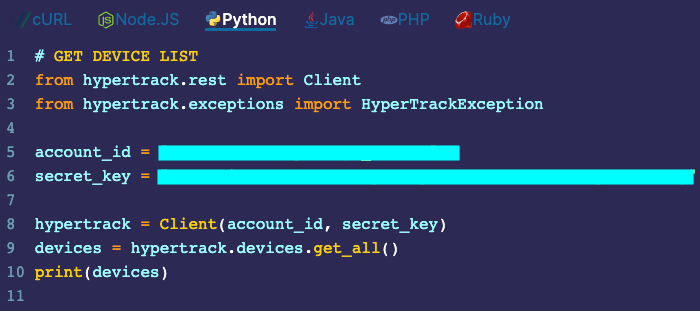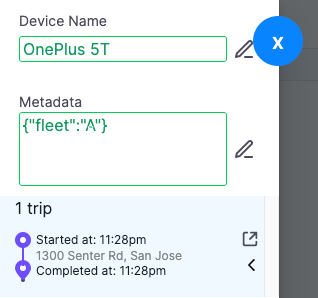

Introducing Playground for developers to build their live location use case
source link: https://hypertrack.com/blog/2020/04/22/live-location-develper-playground/
Go to the source link to view the article. You can view the picture content, updated content and better typesetting reading experience. If the link is broken, please click the button below to view the snapshot at that time.
Introducing Playground for developers to build their live location use case
Product development teams can now build live location use cases within minutes using Playground. It brings the power of live location tracking at your fingertips. You can now control tracking of your devices from the cloud and get inline code snippets to copy-paste into your application. Playground works with all apps built with HyperTrack and pointing to your account. Besides starting and stopping tracking on devices, it may be used to modify device names & metadata, and start & complete trips with destinations.
PlayGround is a great way for developers to see HyperTrack APIs in action and preview how it works. Along with the release of Playground, we also took the time to improve our documentation experience.
PlayGround in action: start and stop tracking devices
To start exploring your devices in PlayGround, start by adding devices using the HyperTrack Live app from the Google Play or App Store.
Once you install this app on your device, login to your account, and grant permissions, you will see your new device on PlayGround in the browser. Once you press the blue "Start Tracking" button, you can see your device on the map.
In your app, you will notice the red Inactive button change to the green Active indicator. Shortly thereafter, the blue button in Playground will change from Start Tracking to the red Stop Tracking button. This means your device has started generating location events and you will see it on the map as a green dot!
PlayGround in action: learning to code
Each action you perform above and in sections below will translate to usable and working code for Node, Python, Java, PHP, and Ruby. Or, run the the API request directly using cURL / Postman.
In the exercises above and below, you can learn how to use HyperTrack Devices and Trips APIs by observing how code snippets change in your favorite language.

PlayGround in action: create and complete trips
With PlayGround, as shown in video, you can also create trips with destination for any of your devices in your HyperTrack account.
As you pick a destination, you can click Create Trip to start a new trip for your device. Shortly after you do so, you will see the app enter the green Active state. Note that under the hood, Trips API automatically starts tracking on your device from the cloud.
You can press the Complete button at any time to complete the trip. If there are no other trips outstanding for your device, it will stop tracking right away, which will be reflected in both in your app as the red Inactive indicator as well as in the PlayGround where the device tracking button will switch to Start Tracking.
PlayGround in action: manage devices
Lastly, PlayGround gives you the ability to change your device name as well as its metadata just as shown in the image below. This functionality gives you a path into HyperTrack embedded views functionality that can empower real-time operational dashboards for your customers. These embedded views use these attributes you set for your devices. Metadata like fleet below can help you create restricted views, by teams, that may be embedded in your ops dashboard.

Giving PlayGround a spin
Now that you learned what PlayGround can do, we invite you to give it a spin. Get a taste of how HyperTrack solves your use cases in tracking business assets on the move.
The easiest way to start is to get your team to install the HyperTrack Live App from the Play Store or App Store.
Once your team members install and launch their app instances, you can see all of them in PlayGround, start & stop tracking devices, set their names & metadata, and create trips with live routes and ETA to destinations.
You will see your HyperTrack views become alive from the actions you have taken on your devices in the PlayGround. You can see your team's devices on the move, observe their activity, health, and location status, and, lastly, their live routes to destinations, with ETA, all in one place in your HyperTrack dashboard!
Once you discover the power of HyperTrack via PlayGround, you can start building your use cases to help with operational efficiency of your business with the following guides:
Subscribe to HyperTrack Blog: Imagine. Build. Repeat.
Get the latest posts delivered right to your inbox
Recommend
About Joyk
Aggregate valuable and interesting links.
Joyk means Joy of geeK